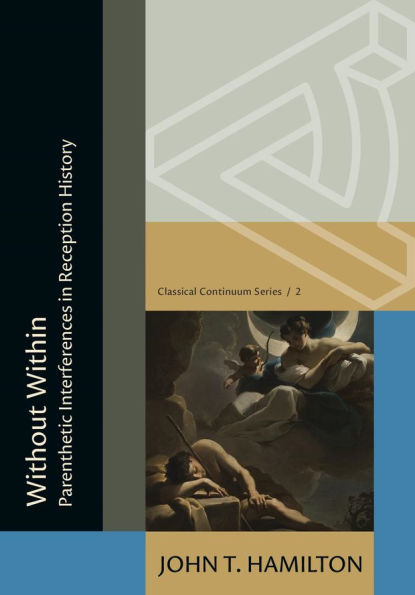Without Within: Parenthetic Interferences in Reception History
Classical reception has always implied a parenthetical relationship insofar as Antiquity appears to be inserted into (en) while remaining alongside (para) Modernity. As in any parenthetical statement, the ancient source can be said to be a part of and apart from modern revisions and reworkings, recontextualizations and reorientations, belonging to a present discourse by maintaining its status beyond it. Through this rhetorical figure, Without Within broaches fresh questions and offers new lines of inquiry in the ever-growing and disparate field of Reception Studies, a field that itself continues to occupy an intriguingly ambivalent position within Classical Studies overall: simultaneously inside and outside, profane and sacred, an included exclusion.
As Quintilian defines it, a parenthesis is a figure of thought (figura sententiae) that occurs “when some thought in the middle interrupts [intervenit] the continuation of a discourse” (Inst. orat. 9, 3.23). In modern typography, this interruption or intervention is generally marked by brackets which introduce a further element of difference or heteronomy vis-à-vis the body of the text. As for specific cases of classical reception, a contrast is thereby staged between the essence of the ancient material and its modern purpose, between the what-is and the what-for. By investigating a series of exemplary instances of reception across several epochs, languages, and cultures, Hamilton aims to delineate and assess the varying contours of Antiquity’s challenge to Modernity and vice versa. What strategies of inclusion and exclusion are operative, and how might they be evaluated? What are the theoretical implications of considering the received past as both external and internal to the present day? How might we qualify the disruption and/or relevance of the past in modern contexts?
1147296747
As Quintilian defines it, a parenthesis is a figure of thought (figura sententiae) that occurs “when some thought in the middle interrupts [intervenit] the continuation of a discourse” (Inst. orat. 9, 3.23). In modern typography, this interruption or intervention is generally marked by brackets which introduce a further element of difference or heteronomy vis-à-vis the body of the text. As for specific cases of classical reception, a contrast is thereby staged between the essence of the ancient material and its modern purpose, between the what-is and the what-for. By investigating a series of exemplary instances of reception across several epochs, languages, and cultures, Hamilton aims to delineate and assess the varying contours of Antiquity’s challenge to Modernity and vice versa. What strategies of inclusion and exclusion are operative, and how might they be evaluated? What are the theoretical implications of considering the received past as both external and internal to the present day? How might we qualify the disruption and/or relevance of the past in modern contexts?
Without Within: Parenthetic Interferences in Reception History
Classical reception has always implied a parenthetical relationship insofar as Antiquity appears to be inserted into (en) while remaining alongside (para) Modernity. As in any parenthetical statement, the ancient source can be said to be a part of and apart from modern revisions and reworkings, recontextualizations and reorientations, belonging to a present discourse by maintaining its status beyond it. Through this rhetorical figure, Without Within broaches fresh questions and offers new lines of inquiry in the ever-growing and disparate field of Reception Studies, a field that itself continues to occupy an intriguingly ambivalent position within Classical Studies overall: simultaneously inside and outside, profane and sacred, an included exclusion.
As Quintilian defines it, a parenthesis is a figure of thought (figura sententiae) that occurs “when some thought in the middle interrupts [intervenit] the continuation of a discourse” (Inst. orat. 9, 3.23). In modern typography, this interruption or intervention is generally marked by brackets which introduce a further element of difference or heteronomy vis-à-vis the body of the text. As for specific cases of classical reception, a contrast is thereby staged between the essence of the ancient material and its modern purpose, between the what-is and the what-for. By investigating a series of exemplary instances of reception across several epochs, languages, and cultures, Hamilton aims to delineate and assess the varying contours of Antiquity’s challenge to Modernity and vice versa. What strategies of inclusion and exclusion are operative, and how might they be evaluated? What are the theoretical implications of considering the received past as both external and internal to the present day? How might we qualify the disruption and/or relevance of the past in modern contexts?
As Quintilian defines it, a parenthesis is a figure of thought (figura sententiae) that occurs “when some thought in the middle interrupts [intervenit] the continuation of a discourse” (Inst. orat. 9, 3.23). In modern typography, this interruption or intervention is generally marked by brackets which introduce a further element of difference or heteronomy vis-à-vis the body of the text. As for specific cases of classical reception, a contrast is thereby staged between the essence of the ancient material and its modern purpose, between the what-is and the what-for. By investigating a series of exemplary instances of reception across several epochs, languages, and cultures, Hamilton aims to delineate and assess the varying contours of Antiquity’s challenge to Modernity and vice versa. What strategies of inclusion and exclusion are operative, and how might they be evaluated? What are the theoretical implications of considering the received past as both external and internal to the present day? How might we qualify the disruption and/or relevance of the past in modern contexts?
19.95
Pre Order
5
1

Without Within: Parenthetic Interferences in Reception History
186
Without Within: Parenthetic Interferences in Reception History
186Paperback
$19.95
19.95
Pre Order

Product Details
| ISBN-13: | 9780674301276 |
|---|---|
| Publisher: | Harvard University Press |
| Publication date: | 09/09/2025 |
| Series: | Classical Continuum , #2 |
| Pages: | 186 |
| Product dimensions: | 5.75(w) x 8.38(h) x 0.00(d) |
About the Author
From the B&N Reads Blog
